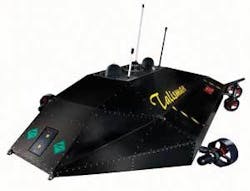UUVs to benefit undersea combat forces
By Courtney E. Howard
Industry innovators are launching competitive designs of unmanned underwater vehicles (UUVs), with the winners earning an early slot in the U.S. Navy’s UUV Master Plan.
The roadmap for the development of UUVs over roughly the next half century, the Master Plan was first published in 2000 and later revisited and revised for cost savings. It calls for the design and production of four classes of UUVs-man-portable, lightweight, heavyweight, and large vehicles, ranging from 100 to 20,000 pounds-each capable of serving multiple needs.
These innovative deep-sea, surface, and remotely operated devices will be suitable for a wide array of missions.
Leaders at the Naval Sea Systems Command (NAVSEA) are poised to award a contract for the current phase, the mission-reconfigurable UUV system (MRUUVS) program, by the end of September.
The MRUUV is designed to be reconfigured on-the-fly for a variety of operations-such as intelligence, surveillance, and reconnaissance (ISR); antisubmarine warfare (ASW); submarine tracking, GPS, and rescue; mine identification and destruction; oceanographic bathymetric surveys; battlespace awareness; strike support; communications and information; port security; and more-through the exchange of modules. A heavyweight system at 21 inches in diameter, 20 feet long, and roughly 4,000 pounds, the MRUUV sports an open architecture that enables the quick and easy exchange of modules, and further promotes less expensive upgrades. The first platforms to receive the MRUUV, scheduled to demonstrate initial operational capability (IOC) by 2008, are Los Angeles- and Virginia-class attack submarines.
“MRUUVS is a key program,” recognizes Tom Jones, director of marine systems at Boeing Integrated Defense Systems in Anaheim, Calif. “Everyone wants to win that. We’re focusing a lot of attention there.”
Boeing’s research and development efforts have culminated in the release of its long-term mine reconnaissance system (LMRS). The company’s 20-foot LMRS is the first UUV to be successfully impulse launched like a torpedo from a submarine’s torpedo tube, and to be docked back on-board while the submarine is underway.
The LMRS can survey underwater environments and, in the process, gather information and detect tethered and bottom mines for as long as 60 hours at a time. The UUV offers semiautonomous operation through the use of its on-board computer, two sonar systems, and inertial navigation system.
“Our acoustic and autonomous control technologies are pivotal in the operation of the LMRS,” Jones says. “The vehicle’s sonar, used for obstacle avoidance, tracking, and mine-like object recognition, has been successfully demonstrated.”
Not to be outdone, BAE Systems’ Underwater Systems division in the United Kingdom has unveiled the Talisman, a modular, multi-role UUV capable of a wide range of operations. The flexible Talisman can perform the dual role of a UUV and USV (unmanned surface vehicle), as well as operate autonomously and enable user intervention at any time.
The Talisman is a large craft measuring roughly 5 by 3 meters that uses mission planning utilities, including software with user-defined presets and parameters, to aid in its autonomous navigation of an ocean course. It can maneuver to avoid obstructions as it seeks out mines, turns 360 degrees, rises to and hovers on the surface to communicate with the operator, and dives again to deploy a smaller UUV, such as a torpedo, for example.
In other news, Seaeye Marine Limited of Fareham, England, has unveiled the Panther Plus, an underwater remotely operated vehicle (ROV) well suited to submarine search and rescue missions. In fact, the Russian Navy uses a Panther Plus fitted with sonar and an acoustic tracking system for locating distressed submarines, color and black-and-white video cameras to furnish rescuers with underwater images, and rotary disc and hydraulic guillotine cutters.
The Panther Plus is capable of forward and lateral movement via 10 brushless DC thrusters with redundant, dual-channel power supplies. A 600-watt lighting system, automatic pilot for depth and heading, electronic depth sensor, 16-bit digital control system, and integrated drive electronics with velocity feedback further round out the new Seaeye underwater ROV. A tethered, but free-swimming unit, it is well suited to the support of distressed submarines-such as through the delivery of emergency life-support pods-and to the recovery of torpedoes.



